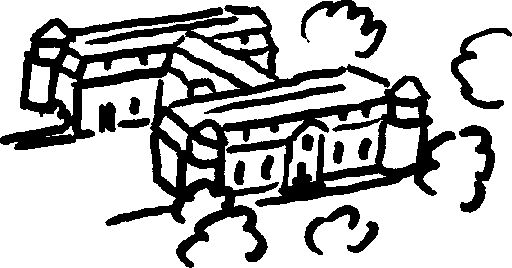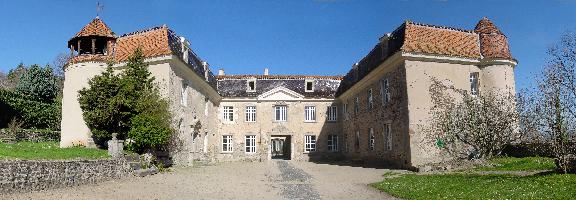

Goutelas 2007 spring school

Low Frequency Radioastronomy :
Instrumentation, Science, Projects
Castle of Goutelas, Marcoux (Loire)
4 to 8 june 2007
CNRS School
Organised by the Paris Observatory
and the French Astronomy and Astrophysics Society (SF2A).
Organization
Situation and aims
Program, Speakers, Participants
Venue
Page web announcing the School
PRESENTATIONS (pdf) and PROCEEDINGS
Key Words : Physics, Astrophysics, Radioastronomy
Public : Researchers, post-doctoral students, graduate students or engineers involved in the future ground-based low frequency radio projects and associated scientific fields, wishing to acquire or update their knowledge of the instrumentation and of the corresponding scientific topics. No previous experience in radioastronomy is required. Bases will be presented.
Scientific Organizers : Philippe ZARKA (LESIA) et Michel TAGGER (APC)
Adresse: Observatoire de Paris
Place Jules Janssen
92195 Meudon
Tél.: 01 45 07 76 63
Fax.: 01 45 07 28 06
E mail: philippe.zarka at obspm.fr
Regional responsible of the project for CNRS: Anita GRASSET
Mission orders and justificatives to send back ASAP to: Martine MATHIEU
Adresse: CNRS, Délégation Alsace, Service des Ressources Humaines, 23, rue du Loess / BP 20, 67037 STRASBOURG Cedex
Tél.: 03 88 10 68 09
Fax : 03 88 10 68 73
E-mail: martine.mathieu at dr10.cnrs.fr
Scientific Committee:
- Pascal Lautridou, SUBATECH, Ecole des Mines de Nantes - Université de Nantes - CNRS/IN2P3
- Michel Tagger, Ingénieur CEA, UMR 7164, APC
- Steve Torchinsky, SKA-DS Project Scientist, USN, Observatoire de Paris
- Philippe Zarka, Directeur de recherche, LESIA, UMR CNRS 8109, Observatoire de Paris
Organization Committee:
- Michel Tagger, Ingénieur CEA, UMR 7164, APC
- Philippe Zarka, Directeur de recherche, LESIA, UMR CNRS 8109, Observatoire de Paris
- Daniel Egret, Astronome, UMS 2201, Observatoire de Paris
- Michèle Dreyfus, UMS 2201, Observatoire de Paris
Situation and aims
This is the 30st Goutelas spring school.
Low frequency radioastronomy corresponds to the domain where coherent detection (amplitude and phase) is possible. t includes direct detection (below about 100 MHz) and heterodyne detection (up to a few GHz), followed by spatial or temporal analysis.
This frequency range quickly develops with the projects SKA (Square Kilometer Array, meter to centimeter range), LOFAR (LOw Frequency ARray, meter to decameter SKA precursor with on-the-moon perspectives), FASR (Fast Agile Solar Radioheliograph), CODALEMA (radio detection of high energy cosmic rays and perspectives in "pulse radioastronomy"). In France, experience comes from the Nançay instruments (Decimeter Radiotelescope, Decameter Array, Radioheliograph) as well as collaborations using the UTR-2 array in Kharkov, the VLA (Very Large Array) in New Mexico, the GMRT (Giant Meterwave Radio Telescope) in India, etc. Low frequency space radioastronomy is also a dynamical domain with many specificities.
Scientific themes will include:
- non thermal phenomena in (magnetized) plasmas through broadband dynamic spectrography (solar, planetary, exoplanetary, pulsar physics...) and imagery (Sun, SNR, galactic/intergalactic magnetic fields, jets...) ;
- atomic and molecular physics (lines and hyperfine transitions) related to cosmology, formation of structures, galaxies, Galaxy, comets ... ;
- particle physics (radio detection of high energy cosmic rays) ;
- etc.
The low frequency radio domain also raises specific instrumental problems, hardware (interferometers made of thousands of antennas, high speed digitization) and software (signal processing for RFI mitigation, polarization measurements, data volumes...).
While instruments and scientific context evolve rapidly, building/maintaining the expertise of researchers and students in this domain is a condition for the optimal exploitation of future instruments.
Public : Researchers, post-doctoral students, graduate students or engineers involved in the future ground-based low frequency radio projects and associated scientific fields, wishing to acquire or update their knowledge of the instrumentation and of the corresponding scientific topics. No previous experience in radioastronomy is required for researches and students is astrophysics and particle physics. Bases will be presented.
Program, Speakers, Participants
The PROGRAM consists of main courses about LF radioastronomy techniques and conferences about related scientific topics and international projects.
The Castle of Goutelas
The 30 past sessions of the Goutelas school, created in 1977 by Evry Schatzman (member of the Academy of Sciences and CNRS gold medal) allowed to introduce more than 1000 students, post-docs and scientists, to innovative methods and topics of modern astronomy and astrophysics.
The cultural center of Marcoux is installed in the castle of Goutelas, built in XVIth century. It can be reached by car and by train (via Lyon/St Etienne) in a reasonable short time from anywhere in France.

Castle of Goutelas. Photo: Emmanuel Bertin (2001)
The Organizers
Contacts : Michele.Dreyfus at obspm.fr , Philippe.Zarka at obspm.fr , Tagger at cea.fr

